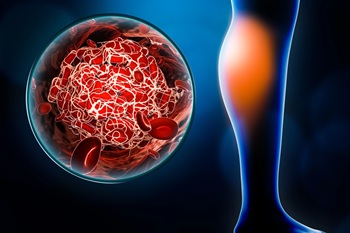STUDY FINDS EXTENDED ANTICOAGULATION BENEFICIAL AFTER PROVOKED VENOUS THROMBOEMBOLISM (VTE)
Patients with provoked VTE and minor VTE risk factors benefited from one year of apixaban
Straight Healthcare
October 2025
October 2025

Current treatment guidelines for provoked VTE (i.e., VTE after immobilization, surgery, extended travel, or pregnancy) recommend three months of anticoagulation. Anticoagulation beyond three months (extended anticoagulation) is typically reserved for patients with strong, persistent VTE risk factors, including active cancer or thrombophilia. The effects of extended anticoagulation on patients with provoked VTE who have minor chronic VTE risk factors (e.g., obesity, CVD) are unknown. To explore this clinical gap, researchers performed the HI-PRO trial, where 600 adults with provoked VTE and minor chronic VTE risk factors were randomized to 12 months of apixaban (2.5 mg twice daily) or placebo after completing at least 3 months of anticoagulation. The prevalence of minor risk factors and results after one year were as follows:
In the HI-PRO trial, extended anticoagulation was superior to three months of anticoagulation in patients with provoked VTE who had minor chronic risk factors for recurrence (55% of participants had two or more risk factors). The first-year VTE recurrence rate in the placebo group was 10%, which is notably higher than the 1–6% rate observed in other studies enrolling patients with provoked VTE. The unexpectedly high placebo recurrence rate and the resulting clinical benefit from extended anticoagulation suggest that current risk stratification models may underestimate the impact of less significant chronic risk factors (e.g., chronic inflammatory disorders, CVD, obesity) when determining the need for indefinite anticoagulation following a provoked VTE. One limitation of the study is the 12-month treatment duration, which may not reflect the full risks and benefits of lifelong anticoagulation. It will be interesting to see how future guidelines incorporate data from this study. In the interim, providers may consider discussing the implications of this study with patients who present with provoked VTE and coexisting minor, long-term risk factors for recurrence.
- Chronic VTE risk factors: Chronic inflammatory or autoimmune disorder - 52%, Obesity - 48%, CVD - 29%, Chronic lung disease - 22%, Chronic kidney disease - 11%
- Symptomatic recurrent VTE: Apixaban - 1.3%, Placebo - 10% (P<0.001)
- Major bleeding: Apixaban - 0.3%, Placebo - 0% (P>0.999)
In the HI-PRO trial, extended anticoagulation was superior to three months of anticoagulation in patients with provoked VTE who had minor chronic risk factors for recurrence (55% of participants had two or more risk factors). The first-year VTE recurrence rate in the placebo group was 10%, which is notably higher than the 1–6% rate observed in other studies enrolling patients with provoked VTE. The unexpectedly high placebo recurrence rate and the resulting clinical benefit from extended anticoagulation suggest that current risk stratification models may underestimate the impact of less significant chronic risk factors (e.g., chronic inflammatory disorders, CVD, obesity) when determining the need for indefinite anticoagulation following a provoked VTE. One limitation of the study is the 12-month treatment duration, which may not reflect the full risks and benefits of lifelong anticoagulation. It will be interesting to see how future guidelines incorporate data from this study. In the interim, providers may consider discussing the implications of this study with patients who present with provoked VTE and coexisting minor, long-term risk factors for recurrence.
